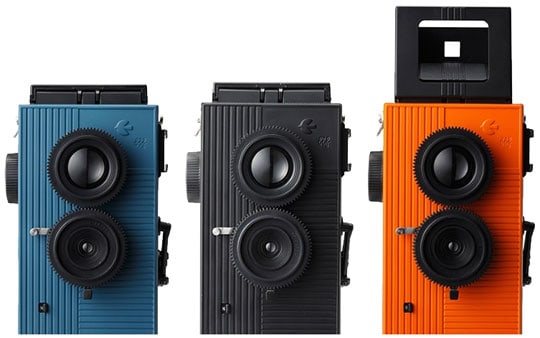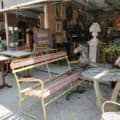Six months ago, I was walking down a street in Brooklyn and stopped at the window of a so-called “design” shop that sold “must-have” items for decorating one’s home. As I looked at the contents of the shop from the outside, my eyes were drawn to three small coloured objects on a shelf. I walked into the shop and approached the shelf; to my surprise, I realised that these candy-like blue, red and green boxes were actually cameras! Twin Lens Reflex, to be precise.
Well, they said they were. After having a closer look at one of them, I realised that they were just VERY cheap copies of a Lubitel (and Lubitel is already a cheap TLR; so try to imagine what a cheap-cheap TLR might look like… Yes, like something CHEAP): they were made of plastic, plastic and plastic. Well, not all plastic, as there were some screws to hold all the plastic together in one piece, and the lenses were made of glass (well, I’m not even sure about that…). And to add insult to injury, these cameras used a 35mm film (in my opinion, a TLR should only use a 120 film: those “square” images you never get with a 35mm are for me the specificity of a TLR).
In short, a piece of crap that costs $90. Yes, that’s right, $90.
Why would some people spend $90 on a TLR-like plastic camera to look cool, when they could get a real camera for a few bucks and actually be cool?
I don’t get it.
Flea markets & garage sales: the best places to find TLR cameras
Brooklyn is by far one of the coolest places in NYC these days: it has everything to do with fashion, coolness and vintage. There are even some people who seem to have been teleported from the 70s just a few seconds ago. I love that.
Most of the people there aren’t pretending. They just are. Nothing fake, just really good old stuff. And I think it would give you more of a headache to try and find new clothes to dress like in the 70s, 60s, 50s or even 40s than to find real stuff from that era! The Brooklyn Flea Market, The Garage, The Hell’s Kitchen Flea Market are some of the places where you can find really cool and authentic vintage clothes for a few bucks.
The same goes for cameras.
I challenge anyone reading this post to name a place that deserves to be called a “flea market” where they can’t find one of those toy or medium format/TLR cameras that seem to have gained new interest among the hipsters for less than $50. I tried and didn’t succeed.
My very own experience with TLR cameras
I found hundreds of them during my two-week trip to NYC. I ended up buying three TLRs (models I’d never seen before or thought I’d ever find on a flea market stand) and brought them back to Europe; so far I’ve tested and compared two of the three cameras I found (the other one needs 620 film and I didn’t have time to rewind a 120 film onto a 620 spool) and I must say I’m very happy with the purchase I made, especially regarding the Mamiya C330: it gives a fantastic image quality compared to the Rolleiflex T model or Yashica Mat. 124G, which I use regularly. Although it’s “quite” bulky, I don’t mind carrying it around with me because it just takes great pictures. And let me tell you, it makes quite an impression on the people around me! They just love it!
Whatever your reason for buying a TLR camera (whether it’s to rediscover the pleasure of analogue photography in an “old-fashioned” way, or to have something cool and authentic to take with you wherever you go, or to spice up your living room), you will eventually find your IDEAL TLR camera. It’s just a matter of time and being an early bird at the flea market. And whatever price you pay for it, as long as you believe in your heart of hearts that THIS IS THE ONE, it’s a great buy.
I now have a dozen or so TLR cameras, all from different manufacturers, and I choose them in the same way you choose your outfit in the morning: depending on the weather, my mood or inspiration. Sometimes I like to use my imprecise Lubitel 2 (Lomo) because it’s just beautifully simple and because it reminds me of a great trip I once took to Venice.
My Rolleiflex T is to me, what a 1965 Shelby 289 Cobra is to a classic car enthusiast: sheer pleasure in the form of the beast and the melody of the mechanics.
And when I leave home with my Mamiya C330 in my rucksack, I’m sure that I’m putting something worthwhile, something of pure inspiration, in the box.
And that is the other pleasure of shooting with an analogue camera: you live for days with the exhilaration of that “anything is possible” feeling, until you finally get your negative; and that feeling is priceless.
7 reasons to buy a real TLR camera
- Genuine TLR cameras & toy cameras can be found at almost any flea market: Lubitel, Rolleicord, Diana, Kodak Brownie, Anscoflex, Voightlanders, Agfa Anastigmat Camera, Mamiya, Bronica (and even a Hasselblad or Rolleiflex if you’re lucky…). You can start your own collection if you’re patient enough and willing to spend $10-$20 every time you find one.
- Most old TLR cameras & toy cameras still work perfectly today. Most of them use 120 film, which can be found and processed almost anywhere. There is even a wide range of professional films that can be used in these cameras: my favourites are Kodak Ektar 100, Kodak 160 VC and NC, Kodak 400 VC and NC, or any Fuji film in 100, 160 or 400 asa/iso). They are easy to find on www.bhphotovideo.com/ or eBay. For 620 film, as in the Ascoflex, you can always rewind a 120 film onto a 620 spool (same width).
- All TLR cameras & toy cameras perform better than the new ones you’ll find in these so-called “design stores” and that will cost you up to a hundred dollars (or even more: at the Metropolitan Museum of Art in New York I found a new edition of a Lubitel 166 for… $350! Please, give me a break). I’ve also noticed that these plastic “would-be” TLR cameras use 35mm film (remember, they’re not medium format cameras!).
- TLR cameras & toy cameras are just GREAT to use and take anywhere. When I was in NYC, I had to leave my Rolleiflex in my backpack because every hundred metres or so someone would stop me to ask about this strange camera or congratulate me on reviving the TLR spirit. TLR cameras are real social boosters.
- Last but not least, you’ll be amazed at the fun (and quality, depending on which TLR you choose) of taking pictures with TLR & Toy cameras. The fun I had with photography disappeared the day I realised that it was my digital camera that was taking great pictures, not me. It also made me lazier (with a digital camera you can shoot anything without worrying about what it will cost to process the images. If you have 12 exposures of film, you think twice before you shoot the same boring scene three times.
- You will learn (or rediscover) photography: Before I started using TLR & toy cameras, I had no idea what to do with my digital camera’s “aperture” and “shutter speed”. In fact, I never had to deal with them as I spent 80% of my time in automatic mode. I learned photography techniques with a good old Lubitel 2. And I bet you’ll enjoy it too.
- And finally, with TLR, you’ll discover this new feeling of “bending with humility” when you take your photo: you don’t aim at your subject like a sniper and “press” the shutter; you hold your camera close to your stomach as if it were part of you, watching the world as if in a mirror, discovering a new reality that your eyes don’t see on their own; and this physical distance between your eyes and the camera’s lens gives you the feeling of watching a film that you’re somehow directing. Pure pleasure.



